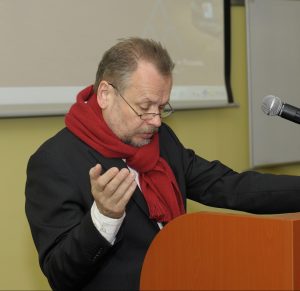Piotr Piotrowski (1952-2015) was an art historian crucial for the research on the art of Central and Eastern Europe in the 20th and 21st century. He was particularly interested in the art created in communist and post-communist Europe, which he analysed in the global political and geographical context.
He was the author of not only pioneer critical monographs providing a collation of artistic trends in the region since 1945 until contemporary times (his publications were translated into several languages, among them: In the Shadow of Yalta: Art and the Avant-garde in Eastern Europe, 1945-1989 (London, Reaktion Books, 2009), or Art and Democracy in Post-Communist Europe (London, Reaktion Books, 2012)), but also of important methodological concepts such as the horizontal art history. His concept of horizontal art history, formulated in a process of writing the history of post-war art created in CEE, proved to be important across the world. It is the most comprehensive proposition for art historians dealing with art created at the ‘peripheries’, but also extraordinarily influential in terms of challenging the discourse of Western art history.
Piotrowski graduated from the Institute of Art History of the Adam Mickiewicz University in Poznań (1971-1976), where he worked from 1980 until his death. During his studies, together with his teacher, Jarosław Kozłowski, he co-created the Akumulatory Gallery. In 1992-1997 he was the director of the section of contemporary art of the National Museum in Poznań, and in 1999-2008 he worked as Institute Director. He was often invited as a guest professor (Center for Curatorial Studies Bard College, USA (2001), Central European University (Budapest, 2002, 2009), Hebrew University (Jerusalem, 2003), University of Warsaw (2011)), participated in scientific internships (Center for Advanced Study in the Visual Arts (Washington D.C., 1989-1990), Columbia University (New York, 1994), Humboldt-Universiät zu Berlin (1997), The Institute for Advanced Study (Princeton, NJ, 2000), Collegium Budapest (2005-2006); Clark Art Institute, Williamstown, MA (2009)) and research grants (British Council (1987, 1988), Kościuszko Foundation (1989), J. P. Getty Foundation (1994, 1998), Deutscher Akademischer Austauschdienst (1997), Trust for Mutual Understanding (2001), Committee for Scientific Research (1997-2000), Ministry of Science and Higher Education (2006-2009)). He wrote eleven books and several hundred scientific articles. He gave several hundred lectures and speeches at scientific conferences. Between 2009-2010 he carried out the function of the Director of the National Museum in Warsaw, trying to implement an innovative and radical concept of a “critical museum”, developed specifically for museums operating in post-communist Europe. As a result of this experience, he wrote the book entitled The Critical Museum, which constituted a case study of trying to apply the assumptions of the new museology in the institution of the National Museum, in the context of post-communist reality.
He received the Award of the Minister of Science and Higher Education (1986, 2006), Jerzy Stajuda Award (1993), Nomination to the Nike Award (2000), Jan Długosz Award (2006), Prime Minister Award for Outstanding Scientific Achievements (2007) and Igor Zabel Award for Culture and Theory (2010), to name just a few.
Piotr Piotrowski was involved in social and political activities. Before 1989, he was a founder and member of university Solidarity and a co-editor of the underground magazine “Obserwator Wielkopolski”. After 1989, he condemned the appropriation of political transformation by the catholic church and participated in debates, discussions and petitions, whose aim was to fight for democratic values, freedom of speech and pluralism of opinions. He was also an avid participant of discussions concerning the shape of universities in the contemporary world.
Piotrowski was a member of numerous scientific organizations, institutions, editorial and advisory boards such as the Association of Art Historians (1976-2000; President of the Poznań Division, 1987-1989), International Association of Art Critics AICA (Vice-President of the Polish Section, 1997- 2003), Association of Art Historians, England, College Art Association, USA, Historians of German and Central European Art and Architecture, USA, The International Council of Museums ICOM (1993-1999), Moderna Galerija, Ljubljana – “2000+ ArtEast Collection” (2000), Los Angeles County Museum of Art – “Exchange and Transformation. Central European Avant-Gardes”; “Between Worlds” (2002), East Art Map – IRWIN (2002), Scientific Council of the Polish Academy of Sciences, Warsaw (1999-2003), Committee for Art Sciences of the Polish Academy of Sciences (2004-2007), Programme Council of the Museum of Modern Art in Warsaw (2005-2007), Erste Foundation (Advisory Panel, 2007-2010), European Network for Avant-Garde and Modernism Studies (Chair, 2009-2010), Praesens, Budapest (International Advisory Committee), Rocznik Historii Sztuki PAN (Annals of Art History of the Polish Academy of Sciences, editorial committee, 2004-2011), Art in Translation (Editorial Board), ARS, Slovak Academy of Science, Bratislava (International Advisory Board).

